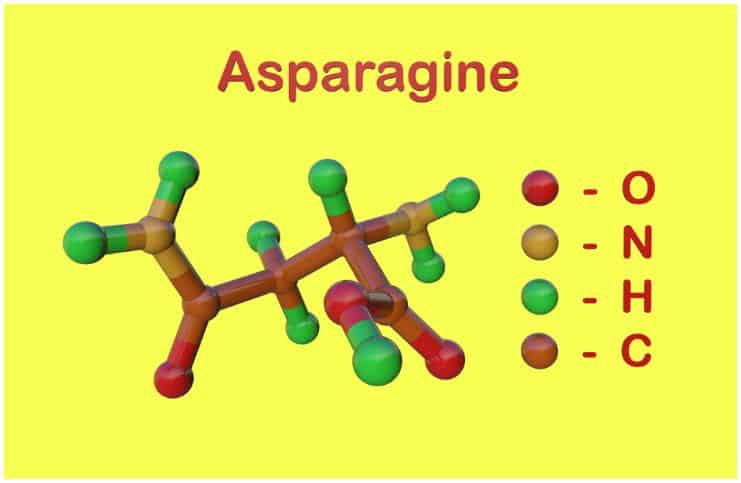Facts
Asparagine (abbreviations N or Asn) is a non-essential amino acid that is coded as AAC and AAU. It requires enzymes and vitamin B6 for its formation.
It has one carboxamide group on the side chain with one amino and a carboxyl group on an alpha-carbon atom. So, this amino acid can be considered an amide of aspartic acid.
It is a polar, neutral, and uncharged amino acid in any biologically proper pH conditions. Moreover, this amino acid is essential to the synthesis of a large number of other proteins and plays an important role in the biosynthesis of glycoproteins (simple proteins with sugar attached to them).
It was the first non-essential amino acid to be isolated from a natural source, asparagus juice, in 1806, by French chemists Pierre Jean Robiquet and Louis Nicolas Vauquelin. The precursor to this amino acid is oxaloacetate (a crystalline organic compound) which is converted to aspartate using a transaminase enzyme.
ASNS (asparagine synthetase) is present in most mammalian organs, however, it varies widely in basal expression. ASNS converts glutamine and aspartate to glutamate and asparagine in an ATP-dependent reaction.
There is a leukemia chemotherapy drug called L-asparaginase that is given as an injection into a large muscle. This drug is isolated from the bacterium Erwinia carotovora or the bacterium Escherichia coli.
Chemical Formula
H2N-CO-CH2-CH(NH2)-COOH
Uses and Health Benefits of Asparagine
- It is required for the development and function of the brain.
- This non-essential amino acid also plays an important role in the synthesis of ammonia (azane). However, the liver usually converts ammonia into urea (also known as carbamide), which is then eliminated in urine.
- It is one of the main and usually the most abundant amino acids involved in the transport of nitrogen. Also, it improves the smooth functioning of the liver as well as increases the resistance to fatigue.
- Extreme mood swings apparently are mediated by the presence of this non-essential amino acid, which helps the body in the maintenance of mental equilibrium. For instance, it protects the mind against either being too sedated or calm to the external environment or being too overly nervous or anxious.
- There is a strong connection between this amino acid and the aspartic acid. Therefore, a deficiency of asparagines will lead to low levels of aspartic acid (an α-amino acid that is used in the biosynthesis of proteins) as it’s involved in aspartate synthesis.
- This amino acid helps maintain an equilibrium of the central nervous system and has therapeutic properties.
Food Sources
This amino acid is not essential for humans, which means that it can be synthesized from the central metabolic pathway intermediates and is not required in our diet.
However, it is found in asparagus, hazelnuts, peanuts, almonds, brazil nuts, pecans, flaxseeds, watermelon seeds, pumpkin seeds, chia seeds, sunflower seeds, sesame seeds, soy products, potatoes, sweet potatoes, navy beans, red kidney beans, chickpeas, adzuki beans, mung beans, millet, oat bran, oatmeal, and more.
Animal sources include – whey, dairy products, poultry, beef, fish, eggs, seafood, and lactalbumin.
Deficiency
A deficiency of this amino acid may contribute to immune system suppression, which ultimately can lead to infections, fatigue, autoimmune disorders, and severe allergies.
Dosage
According to the U.S National Academy of Science, a healthy adult needs 0.36 grams of this amino acid for a pound of body weight. This equals to 0.8 grams of protein per 1 Kg of body weight per individual.
Side Effects of Asparagine
A reaction between this amino acid and reducing sugars or other sources of carbonyls outcomes acrylamide in food, when heated to sufficient temperature.
These products occur in baked goods such as – potato chips, French fries, and toasted bread.
Acrylamide is classified as a Group 2A carcinogen by the IARC and is considered a potential occupational carcinogen by U.S. government agencies.
A February 2018 study of lab mice that was published in Nature concluded that lower levels of this amino acid considerably reduced the spread of triple-negative breast cancer (an aggressive type of cancer that is difficult to treat). This is due to the fact that the human body can produce this amino acid, but tumor cells are unable to.
It is also considered that restricting this amino acid through the diet could be an additional part of treatment for some women with breast cancer.
READ THIS NEXT
References https://pubs.acs.org/doi/abs/10.1021/bi011409j https://www.sciencedaily.com/releases/2018/02/180207140401.htm https://academic.oup.com/jnci/article-abstract/46/2/291/943674?redirectedF

My dog was diagnosed with lymphoma.
I am trying to create an asparagine free diet for her because cancer cells cant make their own asparagine where as healthy cells can. Do you know which foods do not have asparagine?
No, but you should avoid all animal products, oils and foods with oils, alcohol, soft drinks, artificial sweeteners, and foods high in asparagine. Also, quality sleep is important, and 40 minutes per day of mindfulness meditation (to lower your stress levels), and, if you can, 90 minutes per day of walking.